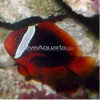[google_adsense_in_post]
The Tomato Clownfish is one of the 27 known clownfish species. Its scientific name is Amphiprion frenatus and it is also known as bridled clownfish, red clownfish, or tomato anemone fish. Clownfish co-exists with anemones in the wild and can shelter from predators near the anemone without being stung or eaten. It may also use coral as a host in the absence of anemone. All the clownfish species are very colorful. The female tomato clownfish is significantly bigger than the male and is blackish on the sides of the body, while the snout, breast and belly are red. The male has a entire red body and has one single white head bar. A young Tomato Clownfish has 2-3 white bars.
Wild tomato clownfish is found in the Western Pacific, from the Ryukyu Islands in Japan, to Malaysia and Indonesia. They are popular in salt water reef aquariums and grow upto 5.5 inches. They need a minimum 20 gallon aquarium with lot of hiding places. Live rock growth is advisable as the tomato clownfish likes to graze. This fish will try to find an anemone belonging to species Heteractis crispa or Entacmaea quadricolor. Some anemone fish are not suitable for Clownfish and will sting and injure the fish.
Tomato Clownfish can show some aggressive behaviors when it reaches maturity, especially towards other clownfish. It is recommended to keep this fish alone or in mated couples. The Tomato Clownfish is an omnivore opportunist and will show a healthy appetite when kept in an aquarium. Provide your fish with a varied and nutritious diet that includes meaty food types as well as some algae or algae based food. A high quality flake food designed for omnivore fish can be a good base. You need to feed this clownfish 2-3 times a day.
The tomato clownfish will usually adapt well to a life in aquarium. A quarantine tank is suggested prior to introduction into the main tank as it helps to rid the Tomato Clownfish of saltwater borne diseases. When Pixar Animation Studios released a film called “Finding Nemo” in 2003, the surge for clownfish increased dramatically. The very hardy Tomato Clownfish can be housed with most fish that will not eat it and is a good choice for tank cycling. It should not be housed with any shy or passive feeding fish, as the Tomato Clownfish tends to be somewhat territorial and aggressive with conspecifics and as it gets older.
As with all known clownfish, most are born as males, and the dominant male will change to a female.






